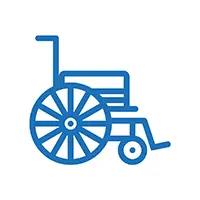Published 22 September 2021

In 2012, Mike Brown was living and working in Australia with his family. His job was stressful so, like many people, he would manage his stress through exercise. Mike loved surfing, but since he couldn’t do that where he lived, he would longboard instead.
“I'd surf the tarmac,” says Mike. “We lived in a sleepy little seaside town and it had this network of pathways that were just perfect for longboarding.”
One morning, Mike left the house to meet his wife and son at the local park down by the beach. It was early in the morning, and there wasn’t really anyone else out.
“I wasn't expecting any cars on the road,” says Mike. “I was kind of just weaving my way down, surfing a wave in my mind. I came up to this final corner, on my side of the road, and looked up to see a car right there cutting the corner.
“I had no chance to really slow down and avoid the collision”
Coming to terms with his new reality
The accident resulted in Mike becoming a paraplegic. This new reality took some time for him to come to terms with.
“It was a huge roller coaster. I had no real idea what a spinal cord injury meant,” says Mike. “I didn't realize that not being able to walk is only the tip of the iceberg in terms of what someone with a spinal cord injury has to deal with. It was massively overwhelming, not just for me, but my wife, parents, friends, and family.”
While Mike struggled with despair and anxiety during this time, there were also flashes of hope and possibility. His life would be different, sure, but that didn’t mean giving up everything that he loved.
“Sometimes someone would share an article or video of somebody doing something as a wheelchair user, and it would give me a flash—it was kind of like going into another dimension—and I’d discover all these new realms of possibility,” says Mike. “There were lots of challenges…but there were snippets of hope that led me to dream about surfing, mountain biking, and skiing again—the things physically that I really enjoyed.”
Designing a mountain bike for wheelchair users
So, Mike continued to pursue a life of adventure. But sometimes he found the enjoyment he got out of his pursuits wasn’t worth the effort or that the experience was quite different to what he was used to—as was the case with mountain biking.
“I thought I'd have to let go of mountain biking, before I got this mountain tricycle from Colorado, says Mike. “But I had to lower my expectations of what it was going to be like, and it was nothing like what I knew mountain biking to be. Not only because you use your arms to propel it, but because it was wide, and most trails just aren’t really made for a wide trike.”
This experience sparked an idea for Mike, what if he could design a two-wheeled mountain bike for wheelchair users?
“I got a group of engineers and creative people together for a barbecue to see what we could come up with,” says Mike. “We started meeting in the evenings and designed a concept which we ended up building and meant I got to ride a two-wheeler again.”
Mike and the team are now up to the fifth prototype of the bike which is the first of its kind.
“There are two major challenges we’re aiming to solve,” says Mike. “One is getting on the bike from a seated position in a wheelchair. So, we’re designing a seating system that raises and lowers so you can get on and off with relative ease. The second challenge is the stability of the bike, preventing the bike from falling over when you're mounting it and when you want to stop along the trail.
“What we're talking about is trying build a mechanical system with the function of the human leg and the processing power of the human brain…so it's a really complex and difficult problem. But we've got a solution that we think will do the trick,” says Mike.
The LapStacker
The mountain bike project was the first for Adaptdefy, a company founded by Mike and his friend Tim Cox, which is on a mission to increase freedom for wheelchair users and the adaptive community. Adaptdefy is most well-known for the LapStacker, the world’s first retractable strap system for wheelchairs.
“One day…I dropped this load of tools I had on my lap and that was kind of the final straw. I thought, ‘I've got to do something about this, I want to be able to carry everything’,” says Mike. “So, we came up with a strap system that attaches to wheelchairs and secures items to your lap.”
The LapStacker has received a great response from users.
“We sent out a survey recently with a number of questions asking for feedback, and overwhelmingly, almost 100% said it was useful, with some going as far to say it’s a game changer. We've also had some feedback of ways to improve it, which we're working on now. It's really exciting.”
Sharing stories of Adaptdefiers
Not content to just produce innovative products, Mike also has a podcast where he interviews other wheelchair users who are pushing past what society might deem possible for them. Mike calls these people Adaptdefiers.
“Everybody's got a story,” says Mike. “One of the very early podcasts I did was with Bruno Hansen, the World Adaptive Surfing champion at the time and his survival story was just incredible. He survived a carjacking in South Africa and the 2004 Boxing Day Tsunami. His struggle with mental health early on and the way he came through that was phenomenal.”
One of the common themes in all of Mike’s interviews (currently 54 and counting) is people finding more strength than they thought they had and overcoming the barriers in society people with a disability tend to face.
“I suppose a lot of the adaption and the resilience that we have as a community comes because of the barriers and ableism around disability,” says Mike. “Hearing everybody's struggle around that was really interesting and highlighted for me the challenge we have as a society to be more inclusive of people of all abilities.”
While there’ still a long way to go towards being a truly inclusive society, Mike is excited by the positive changes that are being made.
“There’s definitely a movement building towards a more inclusive and accepting society,” he says.
Motivated to help others
Mike’s life changed completely on that day in 2012, and while he’s experienced many challenges, he’s also pursued opportunities he might otherwise not have—like setting up his own company to create innovative products to improve the lives of disabled people across the world.
When asked what motivates him and all the work he does, Mike says it’s about giving back.
“I did quite a bit of soul searching this last year,” says Mike. “My motivation used to be achievement and recognition…but now it's very much about giving back and contribution. The idea being that all these small product innovations, all these small contributions, will add up to big and meaningful impacts for people around the world.”














